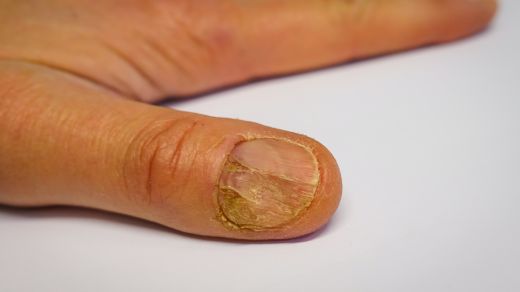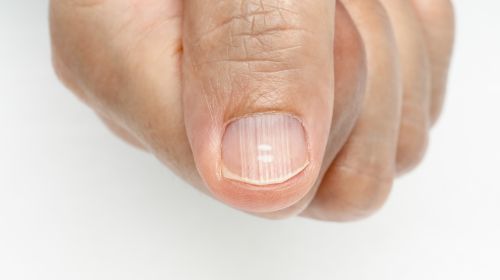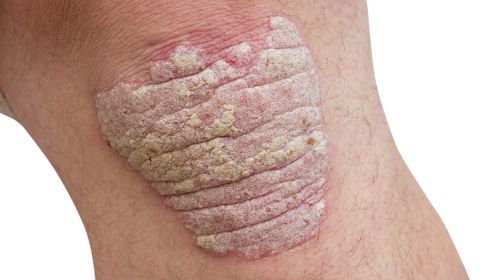One in five people affected by psoriasis have changes in the nail area, i.e. nail psoriasis. Find out here what types there are and what treatment helps with oil stains, spotty nails and crumbly nails!
- © Getty Images/egadolfo
Quick overview: Frequently asked questions and answers
What really helps with nail psoriasis? Topical treatments with special creams, ointments or varnishes, light therapy and, in more severe cases, systemic medications such as biologics help with nail psoriasis.
What does nail psoriasis look like? Symptoms include discoloration under the nail, thickening of the nail plate, changes in the shape of the nail, separation of the nail from the nail bed (onycholysis), and small depressions or pits in the nail (dimpled nails).
Can nail psoriasis go away? Yes, nail psoriasis can temporarily disappear or improve significantly, especially with effective treatment. However, relapses cannot be ruled out.
Is nail psoriasis painful? Nail psoriasis can be painful, especially if it causes thickening of the nail, onycholysis, or inflammatory changes in the nail bed.
At a glance:
What is nail psoriasis?
Experts call psoriasis on the nails nail psoriasis. It can affect the fingernails and also the toenails. So-called spotted nails and oil stains are typical. A particularly severe infestation can lead to the destruction of the nail and the formation of so-called crumb nails.
In addition to the typical skin changes, people with psoriasis also experience nail changes relatively often.
The disease is particularly often found in connection with one Psoriatic arthritis – 70 to 80 percent are affected here. Psoriatic arthritis causes painful inflammation of the joints.
Types of nail psoriasis
Depending on the area of the nail in which the disease occurs, there is a choice between:
- Nail bed psoriasis and
- Nail matrix psoriasis
differentiated. The nail matrix is the visible part of the nails that has grown together with the skin underneath (nail bed).
Nail psoriasis: what symptoms are possible
The severity of nail psoriasis can generally vary. In the early stages, typical nail changes occur on the fingernails and/or toenails.
Often several nails on both hands and feet are affected by psoriasis at the same time. It is not uncommon for the area around the nails to be affected by psoriasis.
The symptoms can severely affect the appearance of the nails. In addition to deformations, the following signs indicate psoriatic nail disease:
Nail bed changes: If there are inflammatory changes in the area of the nail bed, the skin is detached and lifted due to the formation of scales underneath the nail plate.
thickening: The nail plate may thicken and turn yellowish.
Oil stains: If the nail bed area is affected, brown-yellow discoloration occurs under the nail.
Detachment of the nail plate: If the cavities under the nail plate are very extensive, the nail can lose its grip on the nail bed and detach completely. Medically it is called onycholysis.
Spotted nails: These are small, funnel-shaped depressions in the nail surface. They are also called dimples.
Crumbly nails: In severe cases, the surface structure of the nail can be completely changed. This most severe form is known in technical language as onychodystrophy. Colloquially we talk about “crumb nails”.
In addition, the disease can be accompanied by pain if there are inflammatory changes in the nail bed or the nail plate detaches.
Many patients also suffer greatly psychologically from the appearance of their nails and sometimes withdraw socially.
Treatment of nail psoriasis requires patience
Treatment of nail psoriasis is now possible, even in severe forms. On the one hand, medications are used for treatment that are applied internally, and on the other hand, there are products that can be applied, i.e. for external therapy.
Internal treatment is only used for severe forms of nail psoriasis. Eligible:
There are the following options for external treatment of the nails:
cortisone: Tincture applied to the nail bed, also in combination with salicylic acid or calcipotriol
urea (urea): as nail polish or ointment
Sulfur/horsetail: as nail polish
Calcipotriol (vitamin D3 analogues): usually in combination with cortisone
Tacrolimus (Protopic): This is a so-called off-label use because the active ingredient is not approved for the treatment of nail psoriasis.
What those affected can do themselves
Those affected can alleviate the symptoms of psoriatic nail disease by following these tips:
Pay attention to careful nail care and keep nails short
Bathe hands or feet daily in warm salt water
Then care for the skin at the nail root with a lotion
Wear gloves when cleaning, gardening or similar to protect your nails
Protect nails and do not scratch them or anything similar
Care for your nails professionally and possibly have them cosmetically enhanced with suitable varnishes
Course and prognosis of nail psoriasis
Depending on the severity or damage to the nail structure, it can take several weeks to months for the therapy to work. Under certain circumstances, complete treatment of the nails may not be possible. In general, the course and prognosis of nail psoriasis are very individual.
Causes of nail psoriasis
It is not clear exactly how the disease of the fingernails and toenails occurs. A genetic predisposition in combination with certain environmental influences is suspected. Risk factors can include:
- Psychological stress such as stress
- Infections
- sunburn
- Changes in the hormonal balance (e.g. due to puberty or menopause)
- Medications (e.g. antihypertensives or antidepressants)
- Drinking alcohol and/or smoking
This is how nail psoriasis is diagnosed
Nail changes and discoloration should be examined by a doctor as soon as possible. Those affected can first contact a general practitioner or consult a dermatologist directly.
Experts usually recognize psoriasis on the nails by visual diagnosis. In order to rule out other illnesses, a detailed anamnesis is carried out, in which, among other things, the exact symptoms are discussed.
Further clinical examinations confirm the diagnosis. It is important to differentiate nail psoriasis from nail fungus. To do this, the doctor can take a tissue sample (biopsy), which is tested in the laboratory.
The severity of the nail disease can be determined using so-called scoring systems. The therapy is then adapted to individual needs. In order to record the progression of nail psoriasis, pictures can be taken for documentation.


